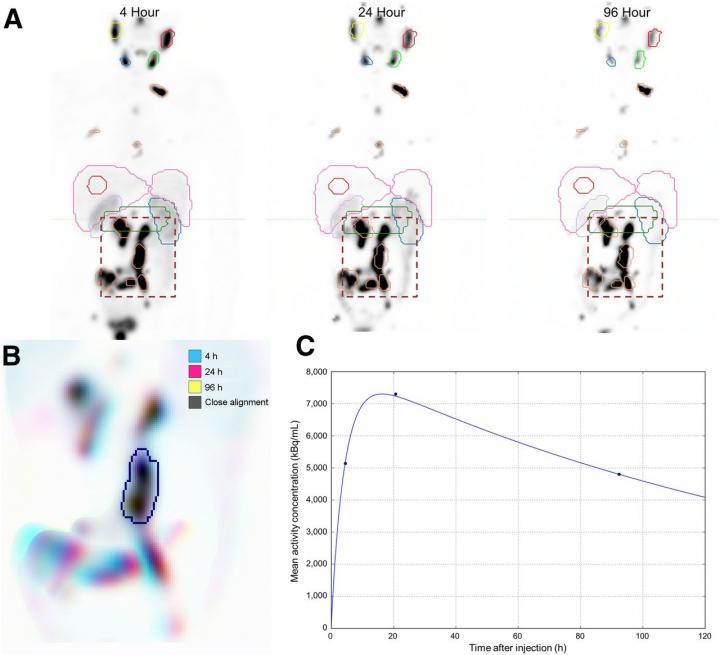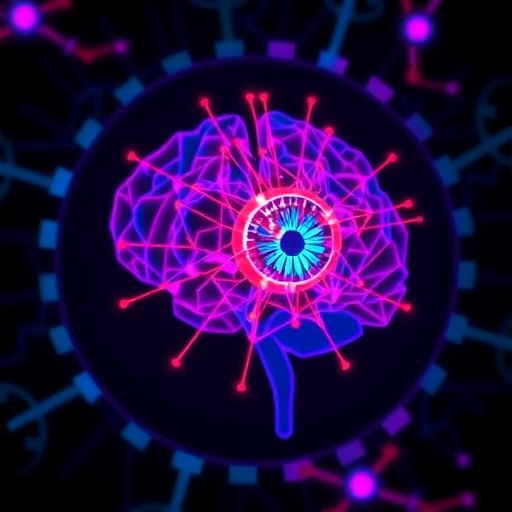
Credit: P. Jackson, M. Hofman et al., Peter MacCallum Cancer Centre, Melbourne, Australia
Reston, VA–Researchers have developed a simplified process that could enhance personalization of cancer therapy based on a single nuclear medicine scan. The novel method uses a follow-up single photon emission computed tomography/computed tomography (SPECT/CT) scan to obtain reliable radiation dose estimates to tumors and at-risk organs. The study is published in The Journal of Nuclear Medicine.
“In most radionuclide therapies, a fixed amount of radionuclide is administered, which does not take into account individual patient variability in tumor and normal tissue uptake, and hence absorbed dose,” said John Violet, BSc, MBBS, MRCP, FRCR, PhD, FRANZCR, radiation oncologist at the Peter MacCallum Cancer Centre in Melbourne, Australia. “‘Dosimetry-led’ administration, on the other hand, where administered activity is adjusted based upon predictable tumor and normal tissue absorbed doses, has the potential to greatly improve therapeutic outcomes. As dosimetry requires multiple SPECT/CT scans post-therapy, however, it is rarely performed outside clinical trials.”
Rather than rely on multiple SPECT/CT scans to calculate dosimetry, researchers sought to develop a dose-response estimation from a single post-treatment scan. The study presented a simplified dosimetry method and applied it to the assessment of 177Lu-PSMA-617 therapy for metastatic prostate cancer. 177Lu-PSMA-617 therapy is known to be a highly active therapy for PSMA-expressing metastatic prostate cancers, but currently there is no standardization of how treatment is given.
In the study, 29 patients receiving 177Lu-PSMA-617 were imaged with SPECT/CT at four, 24 and 96 hours to characterize tracer pharmacokinetics in tumors and in normal tissues of interest. To evaluate serial measurements, three-dimensional volumes of interest were defined on the first image volume and a method was developed to automatically align each contoured subregion and assess pharmacokinetics. This data was used to develop a population PSMA clearance model for tumor and healthy organs.
By applying a generic pharmacokinetic model for PSMA retention, it is possible to estimate radiation absorbed dose with a single image measurement. The range of added uncertainty can be appreciated based on the variability in population curves when normalized to the single time point. Tumor dose estimates were most accurate using delayed scanning at times beyond 72 hours. Dose to healthy tissues was best characterized by scanning patients in the first two days of treatment because of the larger degree of tracer clearance in this early phase.
“This work shows for the first time that following Lu-PSMA administration, it is possible to determine a good estimate of activity and absorbed dose with just a single measurement,” noted Violet. “Simplification of dosimetry methods to make them a routine application would greatly assist in developing radiobiological models specific to Lu-PSMA, and other radionuclide therapies, allowing optimization of therapy for individual patients that are maximally effective and safe.”
Improved understanding of radiation dose-response to radionuclide therapy may provide a rationale for moving away from fixed activity prescriptions. This would allow clinicians to tailor treatments based on an individual patient’s physiology so successive treatment cycles could be adjusted to yield improved treatment outcomes. “The routine application of radiation dosimetry would be an important step in achieving the goal of ‘dosimetry-led’ treatment, providing significant improvements in both the safety and efficacy of treatment,” explained Violet. “The adoption of routine dosimetry across molecular imaging and nuclear medicine in general would be a major advance in the field for both the clinical application of established therapies and the optimization of novel treatments.”
###
This study was made available online in December 2019 ahead of final publication in print in July 2020.
The authors of “Radiation Dosimetry in 177Lu-PSMA-617 Therapy Using a Single Posttreatment SPECT/CT Scan: A Novel Methodology to Generate Time- and Tissue-Specific Dose Factors” include Price A. Jackson, Michael Hofman and Rodney Hicks, Department of Cancer Imaging, Peter MacCallum Cancer Centre, Melbourne, Australia, and Sir Peter MacCallum Department of Oncology, University of Melbourne, Melbourne, Australia; Mark Scalzo, Department of Cancer Imaging, Peter MacCallum Cancer Centre, Melbourne, Australia; and John Violet, Department of Radiation Oncology, Peter MacCallum Cancer Centre, Melbourne, Australia.
Price Jackson is supported by the Victorian Cancer Agency. Michael Hofman is supported by a Clinical Fellowship Award from the Peter MacCallum Foundation and receives research support from Endocyte (a Novartis company). Rodney Hicks is the recipient of a National Health and Medical Research Council Practitioner Fellowship (APP1108050). 177Lu was supplied by the Australian Nuclear Science and Technology Organization (ANSTO) and PSMA-617 by Endocyte and Advanced Biochemical Compounds (ABX). Rodney Hicks holds stock in Telix Pharmaceuticals on behalf of the Peter MacCallum Cancer Centre, with all dividends donated to his department. No other potential conflict of interest relevant to this article was reported.
Please visit the SNMMI Media Center for more information about molecular imaging and precision imaging. To schedule an interview with the researchers, please contact Rebecca Maxey at (703) 652-6772 or [email protected].
About the Society of Nuclear Medicine and Molecular Imaging
The Journal of Nuclear Medicine (JNM) is the world’s leading nuclear medicine, molecular imaging and theranostics journal, accessed close to 10 million times each year by practitioners around the globe, providing them with the information they need to advance this rapidly expanding field. Current and past issues of The Journal of Nuclear Medicine can be found online at http://jnm.
JNM is published by the Society of Nuclear Medicine and Molecular Imaging (SNMMI), an international scientific and medical organization dedicated to advancing nuclear medicine and molecular imaging–precision medicine that allows diagnosis and treatment to be tailored to individual patients in order to achieve the best possible outcomes. For more information, visit http://www.
Media Contact
Rebecca Maxey
[email protected]
Original Source
http://www.
Related Journal Article
http://dx.




